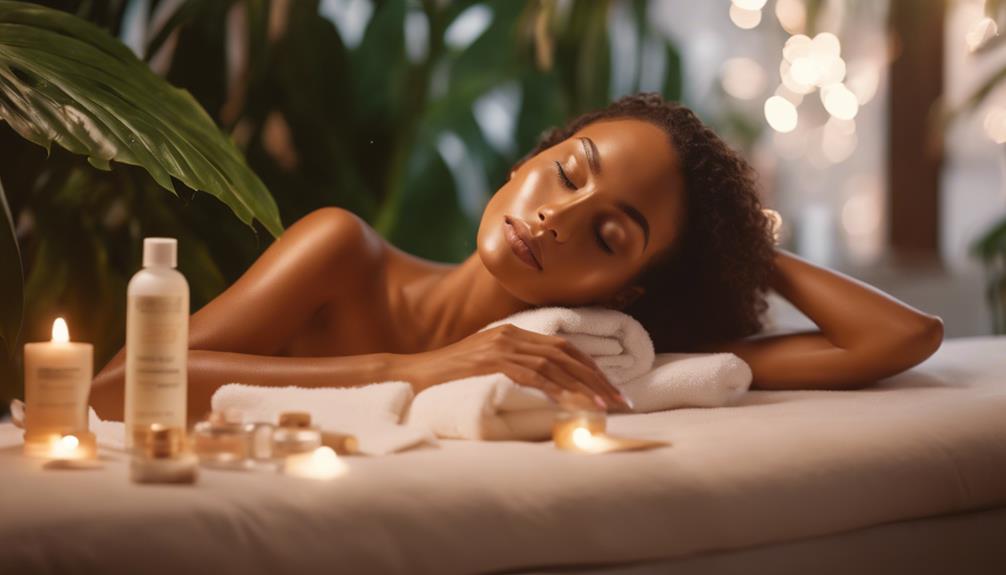Mastering the technique of tanning safely requires a comprehensive approach. Begin by determining your skin type using the Fitzpatrick classification, which assists in identifying your UV sensitivity. Gradually build up tanning exposure to assess your skin’s tolerance. Rotate your body regularly to ensure uniform pigmentation and reduce UV damage. Remember to use non-oil-based moisturizers and protective eyewear during tanning sessions. Once you have achieved your desired tan, maintain it by staying hydrated daily, exfoliating regularly, and reapplying consistently. By following these guidelines, you will not only achieve a radiant tan but also effectively protect your skin health. Further insights are available to enhance your tanning journey.
Key Takeaways
- Determine your Fitzpatrick skin type to tailor your tanning approach and minimize UV damage risk.
- Gradually increase tanning session times to gauge skin tolerance and avoid burns.
- Use non-oil-based moisturizers and indoor tanning lotions to keep your skin hydrated.
- Always wear protective eyewear and rotate your body during sessions for even tanning.
Understanding Skin Types
Understanding skin types is essential for developing a safe and effective tanning routine, as individual characteristics influence UV sensitivity and tanning potential.
The Fitzpatrick skin type classification provides a framework for identifying skin types based on melanin production and reaction to sun exposure.
Individuals with lighter skin tones, such as types I and II, typically have lower melanin levels and higher susceptibility to UV damage, necessitating more cautious tanning approaches.
Conversely, those with darker skin types, such as III to VI, possess greater natural protection but still require careful management to avoid overexposure.
Consulting a tanning expert can provide personalized insights, enabling individuals to select suitable products and develop a tailored tanning plan that optimizes results while prioritizing skin health.
Safe Tanning Techniques
Having established the importance of recognizing individual skin types, it is crucial to implement safe tanning techniques that minimize the risk of UV damage while maximizing tanning effectiveness.
Begin by gradually increasing exposure time, starting with shorter sessions to assess skin tolerance.
Rotating your body during tanning sessions guarantees even pigmentation and reduces localized UV exposure.
Additionally, using non-oil-based moisturizers and specialized indoor tanning lotions prepares the skin effectively, enhancing hydration and reducing the likelihood of burns.
Always prioritize safety by wearing protective eyewear and avoiding overexposure.
Establishing a consistent tanning schedule will help achieve desired results while protecting skin health.
Consulting with tanning professionals can further tailor your approach for ideal safety and effectiveness.
Maintaining Your Tan

Maintaining a sun-kissed glow requires a strategic approach that focuses on hydration, exfoliation, and consistent skincare practices. To prolong your tan, aim to moisturize daily with non-oil-based products that nourish the skin without stripping color. Regular exfoliation is essential to remove dead skin cells, ensuring an even and long-lasting tan.
| Care Routine | Frequency |
|---|---|
| Hydration | Daily |
| Exfoliation | 1-2 times a week |
| Moisturizing | After each shower |
| Reapplication of Tan | Every 3-5 days |
Additionally, consider using a gradual tanning lotion to maintain and enhance your glow while protecting skin health. Prioritizing these practices will help you enjoy your tan safely and effectively.
What are the best practices for safely tanning?
When it comes to secrets to safe tanning, there are a few best practices to keep in mind. First, always use sunscreen with a high SPF to protect your skin from harmful UV rays. Additionally, limit your time in the sun and seek shade during peak hours to avoid overexposure. Lastly, stay hydrated and moisturize your skin regularly to maintain its health.
Conclusion
In the quest for a radiant tan, the irony lies in the pursuit of health through potential harm.
As skin is delicately coaxed under UV rays, one might envision a golden glow, yet this shimmering facade often masks the underlying risks.
The art of tanning safely emphasizes the paradox of beauty entwined with caution.
Ultimately, the journey toward that sun-kissed allure should be one of measured steps, where the glow achieved does not overshadow the integrity of skin health.










